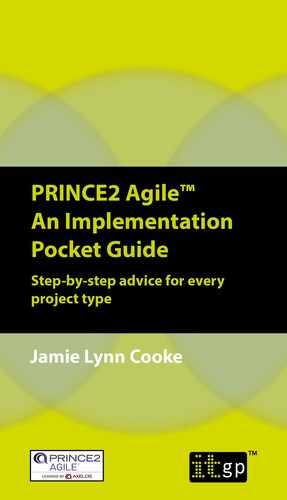CHAPTER 6: MERGING EXISTING PRINCE2 AND AGILE METHODS
The previous section identified the required steps for implementing PRINCE2 Agile by introducing Agile methods into your existing PRINCE2 structure. The approach that was described is ideal for those organizations that have an established PRINCE2 framework with project work traditionally being delivered using waterfall approaches. It is quite possible, however, for PRINCE2 organizations to already have project teams that have been delivering outputs using Agile methods, where the two approaches have been working in parallel instead of using an integrated approach like PRINCE2 Agile.
This includes both situations where the use of Agile methods was explicitly known to the management team, and situations where the decision to use Agile methods was made independently by the project delivery team, even though it had not yet been officially endorsed by the organization (otherwise known as “Agile by stealth”).
If you are implementing PRINCE2 Agile in a PRINCE2 organization that already has project teams using Agile methods (whether or not they were officially endorsed by senior management), this presents both opportunities and challenges for the project work. In most cases, these teams will not have definitive metrics for the work that they have done to date. They are, however, likely to have a number of work products, including Agile communication tools, delivered software, and customer testimonials, which can indicate how well their employed Agile approaches worked. They are also likely to have acquired a substantial amount of knowledge about what does – and does not – work within your organizational culture. All of this information can be applied to selecting the best ongoing approaches for your department to use and the expansion of the project team’s Agile work – now with the benefit of your support.
In this project scenario, the project team can primarily use the 10 steps identified in Chapter 5: Moving from PRINCE2 to PRINCE2 Agile implement their PRINCE2 Agile work with one key activity added at the beginning of the process.
Step 0: Take a pulse point
To fully understand how to integrate your existing PRINCE2 and Agile methods into a cohesive PRINCE2 Agile framework, it is important to know what Agile methods and practices the project delivery team members have been using and how successful (or challenging) these approaches have been.
For example, the project delivery team may have been using Scrum on their own initiative to time-box their work, increase team communication, and focus on delivering the highest-priority features identified by the business.
In their use of Scrum, the delivery team members may have also taken the initiative to establish high-communication channels within the team, such as visible information radiators, face-to-face meetings (instead of numerous back-and-forth emails), and daily stand-up meetings to check in with each other where possible. These are practices that can be leveraged for use in the PRINCE2 Agile framework with minimal overheads and training. It is a “quick win” for the project team.
On the other hand, the delivery team members may have also made arrangements with one or more of their preferred business users to work with the team as “unofficial” customer representatives to clarify and refine their ongoing work. This presents both an opportunity and a challenge in the PRINCE2 Agile framework. It is a positive sign that the project delivery team appreciates the importance of business user input enough to seek it out; however, the value of the input that they have been receiving is contingent upon the capabilities and knowledge of their selected user(s), who may only represent specific business areas – or who may not be senior enough to provide strategic or visionary feedback to the team.
In the PRINCE2 Agile framework, the Project Board and the project manager are responsible for deciding who is in the best position to represent the business requirements for the organization, and assigning them as the product owner(s) for the project, even if the selected person does not have as much hands-on knowledge or history – or availability – as the user(s) who were previously selected by the team. This does not stop the project delivery team from arranging with their preferred users to act as business ambassadors; it does, however, mean that they will need to negotiate for this, where they had been the sole decision-makers before. It also means that the project delivery team members and the selected business ambassadors will need to defer to the officially nominated product owner in product decisions.
This is one situation where existing standalone Agile methods can be both a benefit and a hurdle in an integrated PRINCE2 Agile structure. Project delivery team members will have the experience and knowledge of Agile methods (and possibly the formal certification) which allows them to start project work much more quickly. This experience also provides them with lessons learned on previous projects to make them more efficient. They also, however, may have worked in environments where the project delivery team had the sole authority to make decisions, and they need to adjust this mindset to align with the PRINCE2 Agile governance model.
Once the project team has an understanding of the Agile methods that are already in use within the organization – and their effectiveness – the project can proceed with Steps 1 to 10 as detailed in the previous chapter.
